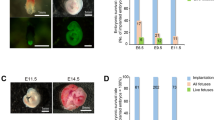Abstract
Family studies inXenopus laevis (2n=36 chromosomes) demonstrate the expression of a single major histocompatibility complex in this species. Mixed leukocyte studies in two families ofXenopus vestitus (2n=72 chromosomes) indicated that this reaction was also under the control of a single genetic region. These studies suggest that, in this polyploid species, the switch from tetrasomic to disomic inheritance has already been accomplished for this locus. In contrast, segregation of mixed leukocyte reaction determinants and patterns of graft rejection in two families ofXenopus ruwenzoriensis (2n=108 chromosomes) were incompatible with the expression of a single major histocompatibility complex, and suggest that polysomic inheritance of this locus is maintained in this species. This interpretation was confirmed by the finding in a sibship of hybrids betweenXenopus ruwenzoriensis andXenopus laevis (2n=54+18) of more than four classes of mixed leukocyte reaction-identical sibs. In laboratory-created triploid animals (trispecies hybrid amongXenopus laevis, Xenopus gilli, andXenopus clivii), mixed leukocyte reaction and grafting experiments demonstrated that the major histocompatibility complex of each constituting species was codominantly expressed.
Similar content being viewed by others
References
Chardonnens, X. and Du Pasquier, L.: Induction of skin allograft tolerance during metamorphosis of the toadXenoups laevis: a possible model for studying generation of self tolerance to histocompatibility antigens.Eur. J. Immunol. 3:569–573, 1973
Du Pasquier, L.: The genetic control of histocompatibility reactions, phylogenetic aspects.Arch. Biol. (Bruxelles)85:91–103, 1974
Du Pasquier, L. and Horton, J.D.: The effect of thymectomy on the mixed leukocyte reaction and phytohemagglutinin responsiveness in the clawed toadXenopus laevis.Immunogenetics 3:105–112, 1976
Du Pasquier, L. and Miggiano, V.C.: The mixed leukocyte reaction in the toadXenopus laevis: a family study.Transplant. Proc. 4:1457–1461, 1973
Du Pasquier, L., Chardonnens, X., and Miggiano, V.C.: A major histocompatibility complex in the toadXenopus laevis (Daudin).Immunogenetics 1:482–494, 1975
Festenstein, H.: Pertinent features of M locus determinants including revised nomenclature and strain distribution.Transplantation 18:555–557, 1974
Günther, E., Balcharova, J., Hála, K., Rüde, A., and Hraba, T.: Evidence for an association between immunoresponsiveness of chickens to (T,G)-A-L and the major histocompatibility system.Eur. J. Immunol. 4:548–553, 1974
Hildemann, W.H.: Components and concepts of antigenic strength.Transplant. Rev. 3:5–21, 1970
Kallman, K.: Genetics of tissue transplantation in Teleostei.Transplant. Proc. 2:263–271, 1970
Klein, J.: An attempt at an interpretation of the mouseH-2 complex.Contemp. Top. Immunobiol. 5:297–336, 1976
Kobel, H.R. and Du Pasquier, L.: Production of large clones of histocompatible, fully identical clawed toad (Xenopus).Immunogenetics 2:87–91, 1975
Miggiano, V.C., Birgen, I., and Pink, J.R.L.: The mixed leukocyte reaction in chickens: evidence for control by the major histocompatibility complex.Eur. J. Immunol. 4:397–401, 1974
Nabholz, M. and Miggiano, V.C.: The biological significance of the mixed leukocyte reaction.In: F. Loor and G.E. Roelants, (eds.):B and T Cells in Immune Recognition, pp. 261–289. Wiley and Sons, Chichester, England, 1977
Ohno, S.:Evolution by Gene Duplication. Springer-Verlag, New York, 1970
Snell, G.D., Dausset, J., and Nathenson, S.:Histocompatibility. Academic Press, New York, 1976
Thiébaud, Ch.H. and Fischberg, M.: DNA content in the genusXenopus. Chromosoma 59, in press, 1977
Tymowska, J. and Fischberg, M.: Chromosome complements of the genusXenopus.Chromosoma 44:335–342, 1973
Weiss, N. and Du Pasquier, L.: Factors affecting the reactivity of amphibian lymphocytes in a miniaturized technique of the mixed lymphocyte culture.J. Immunol. Methods 3:273–286, 1973
Author information
Authors and Affiliations
Rights and permissions
About this article
Cite this article
Du Pasquier, L., Miggiano, V.C., Kobel, H.R. et al. The genetic control of histocompatibility reactions in natural and laboratory-made polyploid individuals of the clawed toadXenopus . Immunogenetics 5, 129–141 (1977). https://doi.org/10.1007/BF01570469
Received:
Issue Date:
DOI: https://doi.org/10.1007/BF01570469



